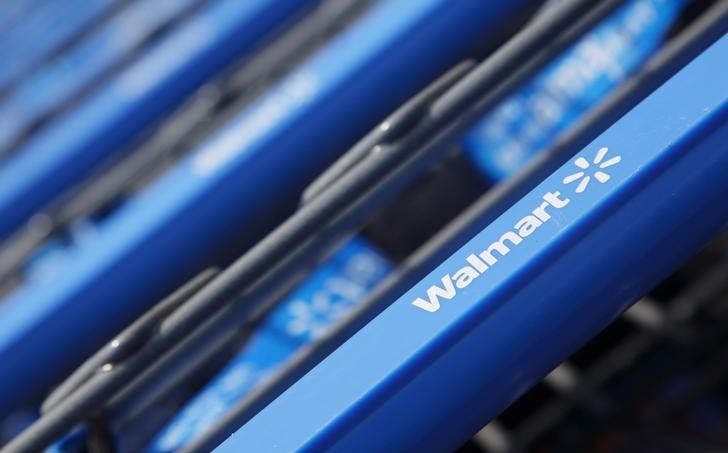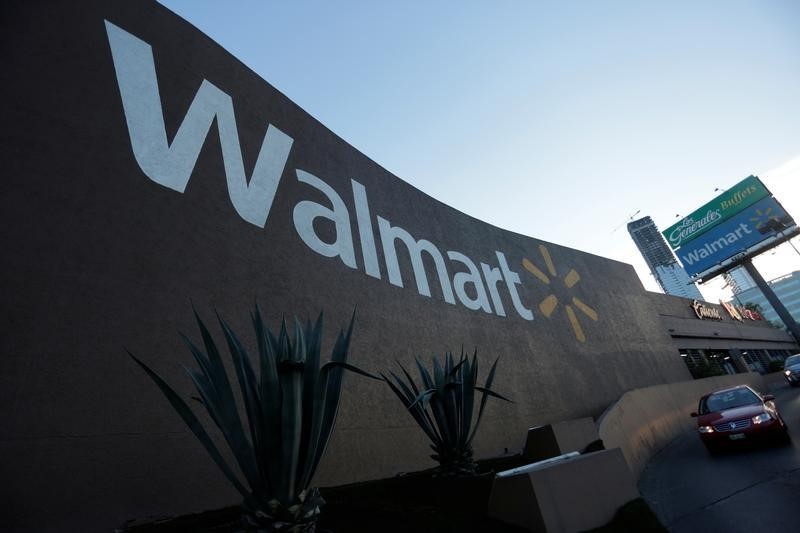By Nandita Bose
CHICAGO (Reuters) - Wal-Mart Stores Inc (N:WMT) reported higher-than-expected U.S. sales on Tuesday for the crucial holiday quarter as its low prices attracted more customers to its stores and online activity accelerated.
Shares of the world's largest retailer rose more than 3 percent as its results bucked a string of disappointing holiday sales figures from rivals including Target Corp (N:TGT), which is due to report earnings on Feb. 28.
Investors shrugged off an 8 percent drop in gross profit margins stemming from Wal-Mart's continued efforts to cut prices to make them more competitive, along with discounts offered after the holiday season.
"A number of things helped Wal-Mart over the holiday quarter," said Neil Saunders, managing director of retail research firm Global Data. "Foremost among these was the strategic decision to invest in price and to heavily promote this fact to consumers."
Wal-Mart said it expected earnings per share of 90 cents to $1 for the current quarter and $4.20 to $4.40 for this fiscal year. Analysts' estimates were within both ranges.
A delay in refund checks from the U.S. Internal Revenue Service has curbed customer spending somewhat, Chief Financial Officer Brett Biggs said on a conference call with reporters. However, he still expects U.S comparable sales - those at stores open at least a year and through e-commerce - to rise 1 percent to 1.5 percent this quarter.
The company said U.S. comparable sales rose 1.8 percent, excluding fuel price fluctuations, during the fourth quarter ended on Jan. 31. Analysts on average were expecting a 1.3 percent increase, according to research firm Consensus Metrix.
Under Chief Executive Officer Doug McMillon and new e-commerce chief Marc Lore, Wal-Mart has been trying to catch up with online rival Amazon.com Inc (O:AMZN). In October, the company said it would slow the pace of new store openings to focus on expanding its e-commerce business.
Biggs said comparable sales were up at all retail formats due to a steady improvement in stores, strong growth from e-commerce and a growing contribution from the online grocery business.
"We've now seen nine consecutive quarters of traffic growth in our stores," Biggs said. "Clearly, we're gaining traction."
U.S. store visits rose 1.4 percent, compared with a year-earlier increase of 0.7 percent.
Despite lower food prices, Biggs said comparable sales rose in Wal-Mart's grocery business, which accounts for nearly 53 percent of overall revenue.
Net income attributable to Wal-Mart fell to $3.76 billion in the fourth quarter from $4.57 billion a year earlier, reflecting the impact from discontinued real estate projects and severance.
Excluding items, earnings per share of $1.30 exceeded the analysts' average estimate of $1.29, according to Thomson Reuters I/B/E/S.
Revenue rose 1 percent to $130.9 billion, with the depreciation of the Mexican peso to the U.S. dollar curbing growth. Excluding currency fluctuations, sales came to $133.6 billion.
E-COMMERCE ACCELERATES
Online sales increased 29 percent, compared with a third-quarter rise of 20.6 percent. That business added 0.8 percentage points to the fourth-quarter comparable sales gain.
Lore said Wal-Mart had a "nice uptick" in online sales after it recently made two-day shipping free in the United States. The retailer will keep looking for acquisitions "wherever it makes sense," he added.
Wal-Mart recently acquired online outdoor clothing and gear retailer Moosejaw for $51 million in cash, its third purchase in about six months.
The company announced a 2 percent dividend increase to $2.04 a share annually.
Shares of Wal-Mart were up 3.2 percent at $71.57 in midday trading. At Friday's close, they had risen 0.4 percent year to date.

(For a graphic on Target and Wal-Mart earnings, click http://fingfx.thomsonreuters.com/gfx/rngs/USA-RESULTS/010020SL1YF/index.html)
